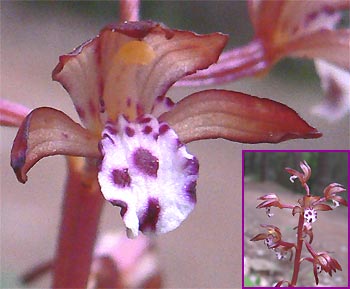
Excerpts from Jim Conrad's
Naturalist Newsletter
from the May 22, 2005 Newsletter issued from the Sierra Nevada foothills
somewhat east of Placerville, California, USA
SPOTTED CORAL-ROOT ORCHID
Down in the moist, deeply shaded valleys Douglas-firs grew to gigantic sizes. We were a few hundred feet higher in elevation there so Sugar Pines mingled with Ponderosas. Sometimes we caught glimpses of the snowfields on the slopes between us and Lake Tahoe and I had to wonder if all that snow ever would melt enough for me to get up there with a backpack and a tent.
Probably the most memorable discovery we made was of a handsome little orchid growing alongside the logging road we walked on. It was the Spotted Coral-root, CORALLORHIZA MACULATA. A cluster of about 10 white, purple-spotted flowers rose about a foot high, the individual blossoms being about ¼-inch long. That's the flower below.

Like the Broom-rape I told you about last week, Coral-root possesses no chlorophyll, has no green parts, and therefore doesn't photosynthesize its own food. Also like Broom-rape, coral-root's stem grows belowground producing no real leaves. However, unlike Broom-rape, which is a parasite, coral-root is a saprophyte. Its roots have a complex relationship with a certain mycorhizal fungus, so the fungus and coral-root work together to break down or convert organic matter to the nutrients they each need.
You can see, then, that coral-roots can only live in a certain kind of place -- where humidity and temperature are high enough and stable enough to be agreeable to the fungus, and the soil's organic matter is of the proper kind and amount. And the moist, protected, deep valley beneath tall conifers where we visited that day seemed to fit the bill.